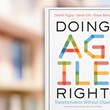Agile has the power to transform work—but only if it's implemented the right way.
For decades, business leaders have been painfully aware of the huge chasm between their aspiration for a nimble, flexible enterprise and the reality of silos, sluggishness, and frustrated innovation. Today, Agile is being hailed as the essential bridge across that chasm. Agile, say its enthusiasts, can transform your company, catapulting you to the head of the pack.
Not so fast. In this clear-eyed and indispensable book, Bain & Company thought leader and HBR author Darrell Rigby and colleagues Sarah Elk and Steve Berez provide a much needed reality check. They dispel the myths and misconceptions that have accompanied Agile's growth—the idea that it can reshape your organization all at once, for instance, or that it should be used in every function and for all types of work. They affirm and illustrate that Agile teams can indeed transform the work environment, make people's jobs more rewarding, and turbocharge innovation — but only if the method is fully understood and implemented the right way.
The key, they argue, is balance. Every organization must optimize and tightly control some of its operations. At the same time, every organization must innovate. Agile, done well, frees and facilitates vigorous innovation without sacrificing the efficiency and reliability essential to traditional operations. Some of the topics covered in Doing Agile Right include:

Agile isn't a goal in itself; it's a means to the end of a high-performance, innovative operation. Doing Agile Right is the must-have guide for any organization trying to make the transition—and for those already there, a way to avoid or recover from its potential pitfalls.

